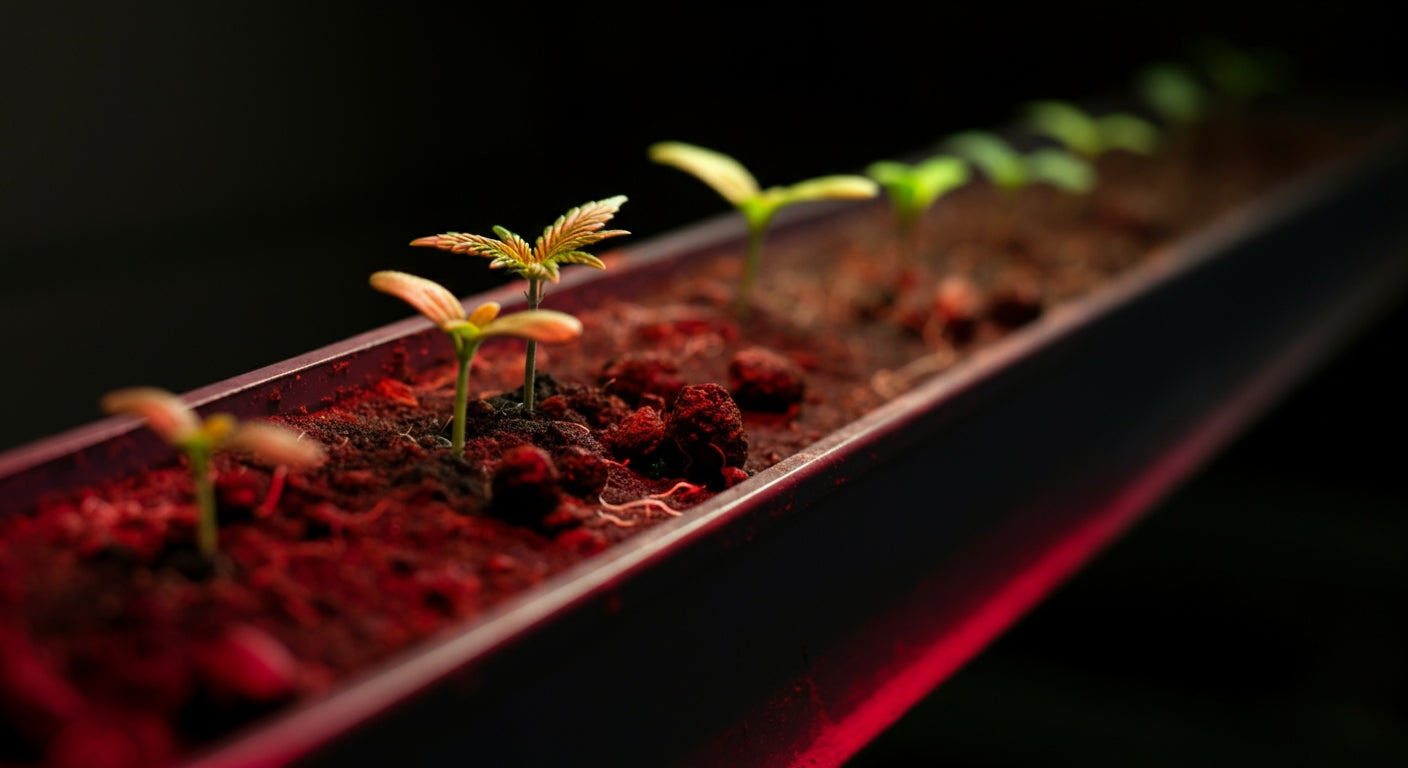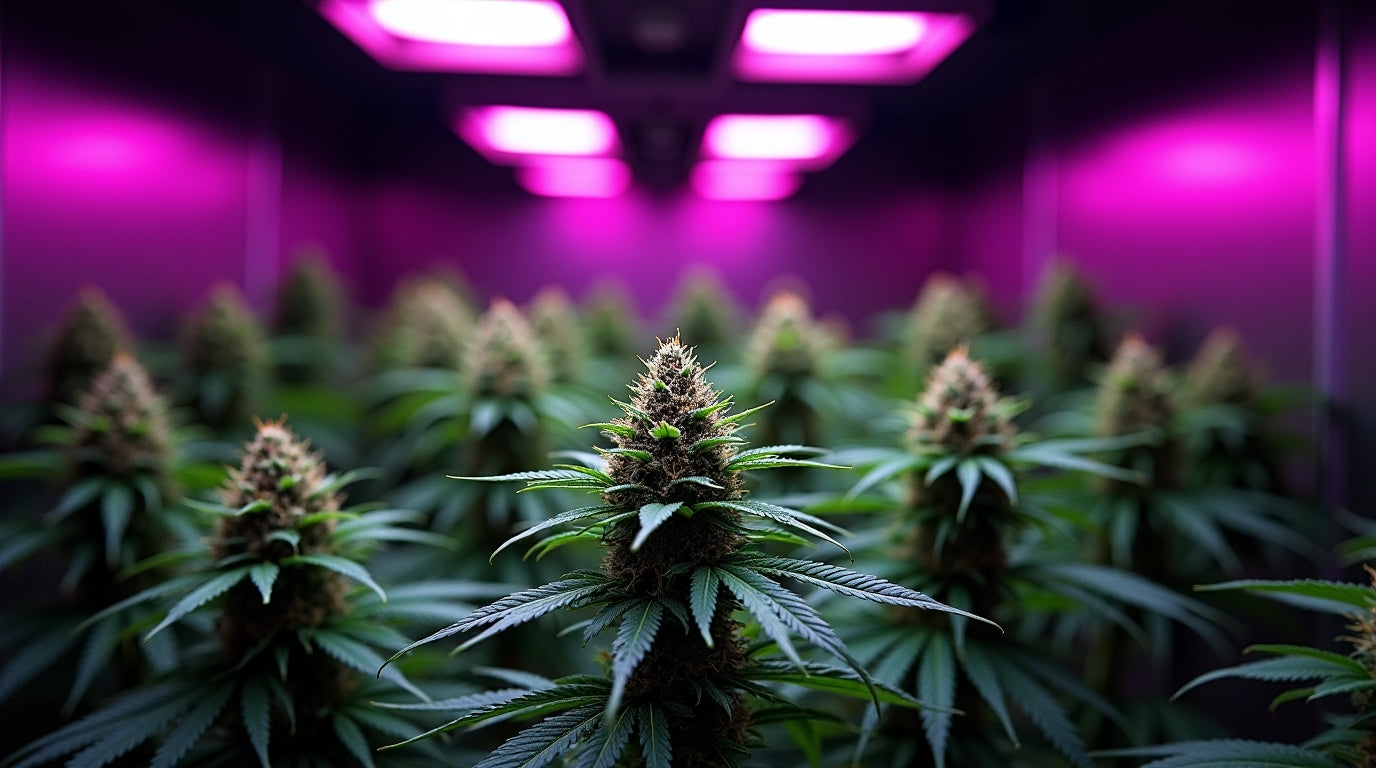
How to Grow Weed Inside: Your Complete Guide to Indoor Cannabis Cultivation
Growing weed inside offers complete environmental control, year-round cultivation, and maximum discretion compared to outdoor growing. Indoor cannabis cultivation allows you to optimize every aspect of your plant's environment, resulting in higher-quality harvests with consistent potency and yields regardless of climate or season.
Whether you live in an apartment, have limited outdoor space, or want complete privacy for your cannabis cultivation, indoor growing provides the perfect solution. With proper equipment and techniques, indoor growers often achieve superior results compared to outdoor cultivation.
This comprehensive guide covers everything you need to know about growing cannabis indoors, from equipment selection to harvest optimization, ensuring your indoor garden produces exceptional results every time.
Why Choose Indoor Cannabis Growing?
Complete Environmental Control
Indoor cultivation puts you in charge of every environmental factor affecting plant growth. Unlike outdoor growing, where weather, pests, and seasonal changes dictate growing conditions, indoor setups allow you to:
Control Climate: Maintain perfect temperature and humidity levels year-round Manage Lighting: Provide optimal light spectrums and photoperiods for each growth stage Prevent Pests: Create sealed environments that exclude most common cannabis pests Ensure Privacy: Grow discreetly without attracting unwanted attention from neighbors or authorities
Year-Round Growing Potential
Indoor growing eliminates seasonal restrictions, allowing multiple harvests per year. While outdoor growers typically harvest once annually, indoor cultivators can produce 3-6 harvests depending on strain selection and growing methods.
Continuous Harvests: Stagger plantings for perpetual growing cycles Climate Independence: Grow regardless of local weather conditions Strain Flexibility: Cultivate tropical sativas in cold climates or experiment with exotic genetics
Superior Quality Control
Indoor environments typically produce higher-quality cannabis with better potency, flavor, and appearance than outdoor grows. Controlled conditions prevent environmental stress that can reduce cannabinoid and terpene production.

Essential Equipment for Indoor Cannabis Growing
Grow Tent Selection and Setup
Gorilla Grow Tents provide the foundation for successful indoor cannabis cultivation. These purpose-built enclosures offer reflective interiors, lightproof construction, and multiple ports for ventilation and equipment mounting.
Size Selection Guidelines:
- 2x2 grow tent: 1-2 small plants, perfect for personal use
- 3x3 grow tent: 2-4 medium plants, ideal for beginners
- 4x4 grow tent: 4-6 plants, serious home growing
- 5x5 grow tent: 6-9 plants, maximum home production
Key Tent Features:
- Reflective Interior: Maximizes light efficiency and distribution
- Lightproof Design: Prevents light leaks during flowering dark periods
- Multiple Ports: Accommodates ventilation, electrical, and monitoring equipment
- Sturdy Construction: Supports heavy lighting and ventilation equipment safely
For beginners, complete grow tent kits eliminate guesswork by including all essential components in properly sized configurations.
Indoor Cannabis Lighting Systems
Lighting represents the most critical component of indoor cannabis growing, directly affecting plant health, growth rates, and final yield quality.
Advanced LED Grow Lights
Modern LED technology has revolutionized indoor cannabis cultivation by providing full-spectrum lighting with minimal heat generation and maximum energy efficiency.
Xi LED Grow Light Series: Specifically designed for cannabis cultivation
- Xi220: Perfect for 2x2 grow spaces
- Xi330: Ideal for 3x3 tent coverage
- Xi420: Optimal for 4x4 growing areas
- Xi750: Professional-grade for large operations
LED Advantages for Indoor Cannabis:
- Full Spectrum Output: Optimized wavelengths for all growth stages
- Energy Efficiency: Significantly lower electricity costs than HID lighting
- Reduced Heat: Easier temperature management in enclosed spaces
- Longevity: 50,000+ hour lifespans reduce replacement costs
Proper Light Distance and Positioning
Understanding optimal LED grow light distance is crucial for maximizing growth while preventing light burn or stretching.
Distance Guidelines by Growth Stage:
- Seedlings: 24-36 inches from light source
- Vegetative: 18-24 inches with monitoring for heat stress
- Flowering: 12-18 inches for maximum bud development
Managing LED grow light heat output ensures optimal growing temperatures while maximizing light intensity benefits.
Ventilation: The Key to Indoor Growing Success
Why Ventilation is Critical
Proper grow tent ventilation is absolutely essential for indoor cannabis cultivation success. Poor airflow leads to temperature problems, humidity issues, and increased disease pressure.
Ventilation Benefits:
- Temperature Control: Removes excess heat from lights and equipment
- Humidity Management: Prevents mold and mildew development
- Air Exchange: Provides fresh CO2 while removing stale air
- Plant Strengthening: Air movement creates stronger stems and branches
Do I Need a Fan in My Grow Tent?
Absolutely yes! Multiple types of fans work together to create optimal growing conditions:
Exhaust Fans: Remove hot, humid air from the growing space Intake Fans: Bring fresh, cool air into the environment Circulation Fans: Move air around plants to prevent stagnant conditions Carbon Filter Fans: Control odors for discreet indoor growing
Should I Put a Fan in My Grow Tent?
Multiple fans are typically required for optimal indoor cannabis growing:
Essential Fan Setup:
- Exhaust Fan: Mounted at tent top to remove hot air
- Oscillating Fans: 1-2 fans for internal air circulation
- Intake Fan: Optional but recommended for larger setups
Best Fan Position for Grow Tent
Strategic fan placement maximizes airflow efficiency:
Optimal Positioning:
- Exhaust: Top corner, opposite from intake
- Intake: Lower side, creating diagonal airflow
- Circulation: Above and below canopy level for complete coverage
Environmental Control for Indoor Cannabis
Temperature Management
Indoor cannabis thrives within specific temperature ranges that vary by growth stage and photoperiod.
Optimal Temperature Ranges:
- Seedling Stage: 75-80°F (24-27°C) with minimal fluctuation
- Vegetative Growth: 75-85°F (24-29°C) during lights on, 65-75°F (18-24°C) lights off
- Flowering Stage: 65-80°F (18-27°C) with cooler nighttime temperatures
Temperature Control Methods:
- Ventilation Systems: Primary method for heat removal
- Air Conditioning: For hot climates or large growing operations
- Heat Sources: Small heaters for cold environments or winter growing
Humidity Control Strategies
Proper humidity levels prevent mold while supporting healthy plant development throughout all growth stages.
Humidity Requirements by Stage:
- Germination: 70-90% for successful sprouting
- Seedling: 65-75% for healthy leaf development
- Vegetative: 55-70% for optimal growth rates
- Flowering: 40-50% to prevent bud mold and rot
How to Increase Humidity in Grow Tent: Use humidifiers, wet towels, or water trays when humidity is too low.
Reducing High Humidity: Increase ventilation, use dehumidifiers, or reduce watering frequency when humidity exceeds optimal ranges.

Space Optimization and Growing Techniques
Maximizing Yields in Limited Space
Indoor growing space is typically limited, making efficient use of available area crucial for achieving maximum yields.
Plant Training for Indoor Growing
Low Stress Training (LST): Bend and secure branches to create even canopies that maximize light exposure in limited vertical space.
Screen of Green (SCROG): Trellis netting techniques create uniform canopies perfect for indoor tent growing.
Sea of Green (SOG): Grow many small plants to minimize vegetative time while maximizing harvests per square foot.
Topping and FIMing: Pruning techniques that encourage multiple colas, increasing yields without requiring additional floor space.
Vertical Growing Opportunities
Height Extension Kits allow growers to add 1-2 feet of vertical space when plants outgrow standard tent heights.
Multi-Level Growing: Advanced growers can create multiple growing levels within tall tents, effectively doubling growing capacity.
Stealth and Discretion Considerations
Odor Control Systems
Cannabis produces distinctive odors that require management for discreet indoor growing.
Carbon Filter Systems: Essential for eliminating cannabis odors before exhaust air leaves the growing space. Replace filters every 12-18 months for optimal performance.
Ozone Generators: Advanced odor elimination for large-scale operations, though proper ventilation is required for safety.
Negative Pressure: Properly configured ventilation creates slight negative pressure, ensuring odorous air passes through filtration before escaping.
Noise Reduction Strategies
Quiet Equipment Selection: Choose fans and pumps rated for low noise output to avoid attracting attention.
Sound Dampening: Use acoustic insulation around noisy equipment or grow tent exteriors.
Timer Management: Schedule noisy equipment operation during daytime hours when ambient noise levels are higher.
Light Security
Complete Light Sealing: Prevent light leaks that could indicate indoor growing activities to neighbors or authorities.
Window Coverings: Use blackout curtains or reflective materials to prevent grow light detection from outside.
Ventilation Light Traps: Install baffles in ventilation ducting to prevent light leaks through exhaust ports.
Advanced Indoor Growing Systems
Automated Indoor Growing
Modern technology enables highly automated indoor cannabis cultivation that reduces daily maintenance while optimizing results.
Automated Systems Include:
- Smart Lighting: Programmable LED systems with spectrum control
- Climate Control: Automatic temperature and humidity management
- Irrigation Systems: Automated watering and nutrient delivery
- Environmental Monitoring: Smartphone-connected sensors and alerts
Hydroponic Indoor Growing
Advanced hydroponic systems offer significant advantages for indoor cannabis cultivation:
Hydroponic Benefits:
- Faster Growth: Direct nutrient delivery accelerates development
- Higher Yields: Optimized nutrition often increases harvest weights
- Space Efficiency: Soilless systems require less space per plant
- Cleaner Growing: No soil means fewer pest and disease issues
Popular Indoor Hydroponic Methods:
- Deep Water Culture (DWC): Simple and effective for beginners
- NFT Systems: Nutrient film technique for maximum growth rates
- Ebb and Flow: Flood and drain systems offering flexibility and reliability

Indoor Growing Challenges and Solutions
Common Indoor Growing Problems
Temperature Fluctuations: Inconsistent temperatures stress plants and reduce yields. Install proper ventilation and temperature monitoring to maintain stable conditions.
Humidity Extremes: Both high and low humidity create problems. Use humidifiers, dehumidifiers, and improved ventilation to maintain optimal levels.
Light Burn: Excessive light intensity or heat can damage plants. Monitor LED grow light distance and adjust positioning based on plant response.
Poor Air Circulation: Stagnant air promotes mold and weak stems. Ensure adequate fan placement and airflow throughout the growing space.
Pest Prevention in Indoor Environments
Sealed Environment Benefits: Properly sealed grow tents prevent most outdoor pests from entering growing spaces.
Prevention Strategies:
- Clean Growing Practices: Sterilize equipment and maintain clean growing areas
- Quarantine New Plants: Isolate clones or new plants before introducing to main growing area
- Environmental Controls: Maintain optimal conditions that favor plants over pests
- Regular Monitoring: Weekly plant inspections catch problems before they spread
Nutrient Management Indoors
Understanding plant nutrition becomes more critical indoors where plants depend entirely on grower-provided nutrients.
Indoor Nutrient Considerations:
- Complete Nutrition: Indoor plants require all macro and micronutrients from external sources
- pH Management: Monitor and adjust nutrient solution pH for optimal uptake
- Feeding Schedules: Establish consistent feeding routines based on growth stage and plant needs
- Water Quality: Use filtered or RO water for consistent nutrient delivery
Strain Selection for Indoor Growing
Best Cannabis Strains for Indoor Cultivation
Indica-Dominant Strains: Generally better suited for indoor growing due to:
- Compact Size: Shorter plants work better in limited height spaces
- Faster Flowering: 6-9 week flowering periods enable quicker harvests
- Dense Buds: Higher yield per square foot ratios
Hybrid Varieties: Offer balanced characteristics ideal for most indoor setups:
- Predictable Growth: Known characteristics make planning easier
- Moderate Size: Manageable plant dimensions for most tent sizes
- Quality Results: Proven genetics produce consistent, high-quality harvests
Autoflowering Options: Perfect for beginners or continuous harvesting:
- Size Control: Naturally compact plants ideal for small spaces
- Simple Light Cycles: No photoperiod management required
- Quick Turnaround: 8-12 week seed-to-harvest cycles
Indoor Growing Timeline Planning
Perpetual Harvests: Stagger plantings every 2-4 weeks for continuous harvests throughout the year.
Seasonal Considerations: Indoor growing eliminates seasonal restrictions, but electricity costs and ambient temperatures may vary.
Harvest Planning: Plan harvests around personal schedules, as drying and curing require 4-8 weeks post-harvest attention.
Legal and Safety Considerations
Home Growing Regulations
Before starting any indoor cannabis cultivation, research local and state laws regarding home growing:
Common Legal Requirements:
- Plant Count Limits: Maximum number of plants allowed per household
- Growing Location Restrictions: Requirements for locked, secure growing areas
- Age Restrictions: Minimum age requirements for home cultivation
- Sharing Limitations: Rules about distributing homegrown cannabis
Safety Considerations for Indoor Growing
Electrical Safety: Cannabis grows require significant electrical loads. Ensure proper wiring, GFCI protection, and avoid overloading circuits.
Fire Prevention: High-intensity lighting and ventilation equipment create fire risks. Install proper circuit protection and maintain equipment regularly.
Security Considerations: Protect your investment and maintain discretion through proper security measures and low-profile growing practices.
FAQ Section
Is it better to grow weed inside or outside?
Indoor growing offers complete environmental control, year-round cultivation, and better security, while outdoor growing provides larger potential yields and lower operating costs. Complete indoor grow setups typically produce higher-quality cannabis with more consistent results.
How much does it cost to grow weed inside?
Initial setup costs range from $500-2500 depending on tent size and equipment quality, with ongoing electricity costs of $50-200 per month. Professional grow tent kits provide better value by including all essential components.
What size grow tent do I need for indoor cannabis?
A 3x3 grow tent accommodates 2-4 plants and is ideal for most home growers, while 4x4 tents provide space for 4-6 plants for serious cultivation.
How much electricity does indoor cannabis growing use?
LED grow lights typically consume 0.25-0.5 watts per square foot, making a 3x3 grow tent setup use approximately 200-400 watts during operation, similar to running a small refrigerator.
Do I need special ventilation for growing cannabis indoors?
Yes, proper ventilation systems are essential for temperature control, humidity management, and odor elimination. Carbon filters are particularly important for discreet indoor growing.
Summary
Bottom Line: Indoor cannabis growing provides complete environmental control, year-round cultivation potential, and superior discretion compared to outdoor methods. Success requires proper equipment selection, environmental management, and attention to detail throughout all growth stages.
Indoor cultivation eliminates weather dependency while enabling multiple annual harvests of consistently high-quality cannabis. With proper setup and maintenance, indoor growers achieve superior results with enhanced privacy and security.
Start Your Indoor Cannabis Growing Journey Today
Transform any indoor space into a professional cannabis cultivation facility with equipment designed for optimal results. Gorilla Grow Tent provides everything necessary for successful indoor growing, from complete tent kits to advanced LED lighting systems.
Whether you're starting with a compact 2x2 setup or building a serious 5x5 operation, our equipment ensures optimal conditions for maximum yields and quality. With professional ventilation systems, environmental controls, and lifetime growing support, you'll consistently achieve exceptional results.
Don't wait to start your indoor growing adventure. Browse our complete selection of indoor growing equipment and automated growing systems to build the perfect indoor cultivation setup. Join thousands of successful indoor growers who trust Gorilla for consistently outstanding harvests, year after year.

Lena Myles
I'm a mushroom enthusiast and home cook based in Oregon. I'm passionate about foraging and creating fungi-focused recipes, especially delicious, plant-based dishes using gourmet mushrooms like trumpet, shiitake, and oyster. When I’m not in the kitchen, you’ll usually find me wandering the woods in search of new wild flavors.


